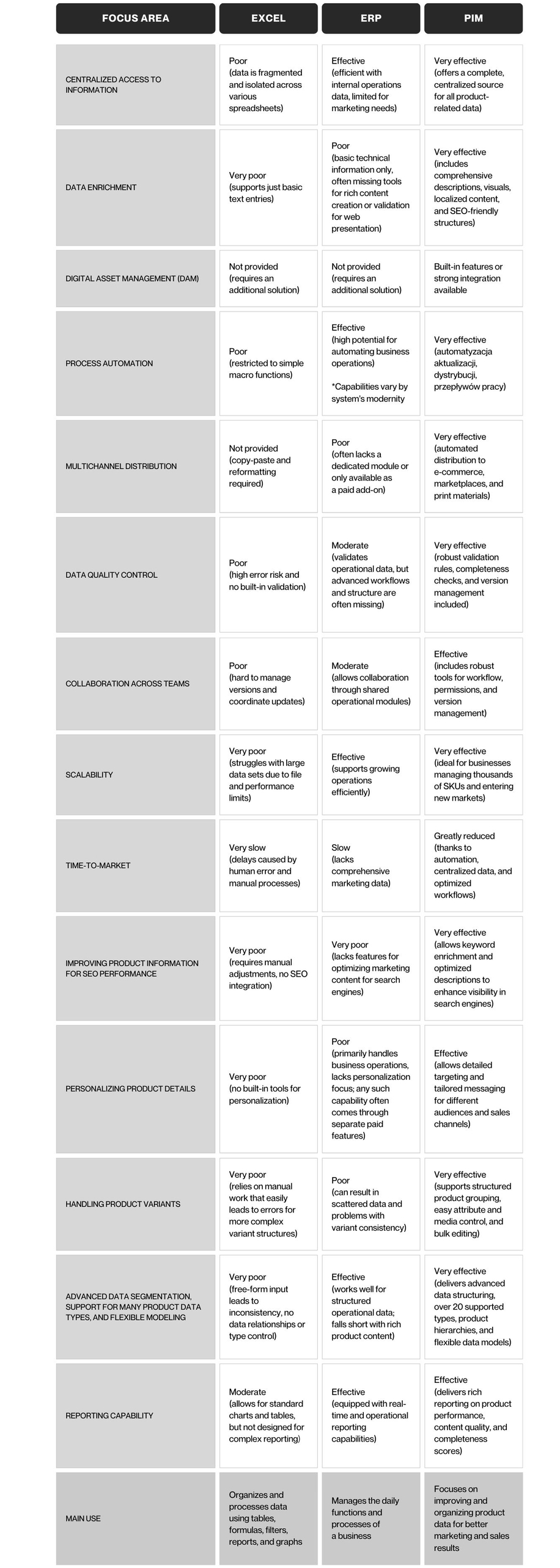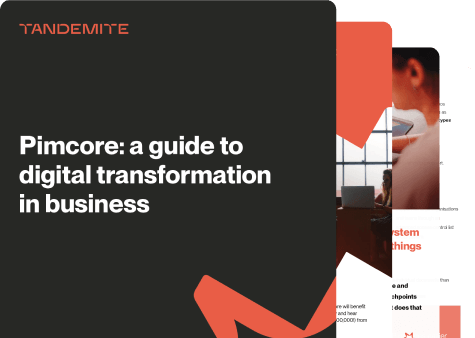If your product data lives in Excel or an ERP system, it might be doing the job – for now. But the more products, sales channels, and customer demands you juggle, the more likely it is that it will break down.
A Product Information Management system helps you take control before the chaos starts. This article explores why PIM is the key to sustainable growth, satisfied customers, and peace of mind.
How do things usually look at the start? Excel and ERP handle the product data
When a company steps into e-commerce, it makes sense to begin with tools already in use. These are usually spreadsheets like Excel or an ERP system (short for Enterprise Resource Planning), which supports managing various business operations like finances, stock, and sales.
Initially, with just a small product range, Excel appears to be a manageable solution. You can list product names, technical details, and brief descriptions, sometimes even image URLs. ERP systems often provide more depth, connecting product data to inventory levels and pricing. On the surface, it looks like everything you need is in place.
Many of the business owners we work with started exactly like this. It’s understandable. Those tools are already part of the workflow, and the team is comfortable with them. So why look beyond what’s already there?
Things start to get complicated when your business begins to grow. Managing more products, selling across marketplaces, and expanding to other countries puts pressure on the methods that once served you well, and their limitations quickly become clear.
What are the limitations of Excel and ERP in managing product data?
As we’ve mentioned, Excel and ERP might feel like suitable tools at the beginning of your data journey. However, as your operations grow and change, the shortcomings of these systems become more evident. Let’s examine the typical traps that can disrupt your workflow.
Excel challenges in product information management
Unstructured data and lack of centralization: Visualize a company where every department manages product data in its own spreadsheet. In such a setup, maintaining consistency and accuracy becomes almost impossible. The result is frequent errors, mismatched product details, and customer frustration.
A single document can create a chain of mistakes, resulting in substantial financial loss.
Human error: In Excel, the margin for error is high – from wrong size entries to incorrect image links or text mistakes. When multiple people are involved and files start circulating in different versions, it's a fast track to chaos. You lose visibility into who made changes and when, and it’s no longer clear what you're really showing customers.
Workflows are hard to streamline: Excel was never intended for managing product data as a team. It offers no easy way to track responsibilities, approvals, or progress stages. Without a clear workflow, the time needed to bring new products to market increases, and team coordination suffers.
Growth in products and sales channels becomes hard to support: When your inventory grows and you want to sell across multiple platforms, in addition to your website, using Excel to manage it all becomes increasingly difficult. Every sales channel demands different data formats, unique descriptions, and image standards. Customizing these manually for each platform is time-consuming and opens the door to costly mistakes.
Rich content requires better tools to manage and update effectively: Product detail pages depend on more than just well-written text. They also need rich media like photos, videos, 3D models, user guides, and official certificates. Excel is not a practical tool for managing or linking these materials effectively.
Key processes cannot be automated: Tasks such as importing supplier data, exporting to sales platforms, and updating information in all channels are ideal for automation. Unfortunately, Excel doesn’t support these workflows, resulting in wasted time on manual, routine work.
ERP challenges in product information management
Emphasis is placed on order processing, not marketing capabilities: ERP systems are great tools for controlling orders, invoices, and warehouse inventory. However, their primary function is not to support the marketing side of product presentation. As a result, they often lack the tools to create engaging descriptions, manage images in the formats and sizes needed for online use, or adapt content for multiple sales platforms.
Limited options for configuring custom attributes and flexible categorization: E-commerce relies on flexible product descriptions, with attributes such as color, size, material, and weight, and on logical, customer-oriented categorization. Unfortunately, many ERP systems are built on strict data structures that often fail to accommodate the dynamic needs of digital sales and marketing teams.
While some enterprise ERP systems do offer modules to manage such complexity, these are often costly add-ons, available only through premium subscriptions or specialized configurations.
Barriers in creating compelling marketing copy and emotional product narratives: Product descriptions should be informative, but they also need to engage customers and build emotional appeal. ERP systems, on the other hand, are usually not tailored to support this type of expressive, marketing content effectively.
Additional development is required to meet business expectations for PIM functionalities: When an ERP system lacks native support for product data, customizing it to fit that role can be a complex and costly process. It usually demands expert intervention and several non-standard adjustments to bridge the gap.

!IMPORTANT! While ERP systems offer some functionality for handling product data, this is usually limited and geared more toward internal workflows than toward showcasing information for customers. For more advanced handling of product information, extra investment may be necessary – either through paid add-ons or by connecting the ERP to external solutions.
Why is PIM worth implementing?
With PIM, you can store, enhance, and distribute all product-related information – technical data, marketing descriptions, images, videos, and translations – from one organized system.
Explore how PIM is designed to tackle the exact issues we outlined earlier:
1️⃣ Smooth scaling of online sales: A PIM system is purpose-built to manage vast and growing product catalogs – from hundreds to millions of SKUs. It simplifies everything from adding new products to managing detailed attributes and organizing them into categories. If expanding your catalog is on the horizon, PIM is the tool that supports your ambitions.
2️⃣ Managing complex data sets while enabling better team cooperation: Put an end to scattered files and constant email threads. A PIM centralizes product information, allowing departments like marketing, sales, customer support, and logistics to work from one coherent source. Every team member knows their area of responsibility, while workflow automation ensures product data is created, reviewed, and approved efficiently.
3️⃣ Tailoring customer journeys to individual needs: Customers now expect product content that speaks directly to their needs and provides detailed insights. PIM gives you the tools to create customized, enriched descriptions for each sales channel and customer segment. It also makes it simple to include unique product attributes, specifications, and stories that build trust and help close the sale.
4️⃣ Integrating systems into one efficient workflow: PIM does not function in a vacuum. Its greatest advantage is its ability to link with the systems you already use – e-commerce platforms such as Shopware or Magento, ERP systems (which it supports rather than replaces!), CMS platforms for managing content, and marketing tools. These integrations allow product data to move seamlessly between platforms, removing the need for repetitive tasks and reducing error risks. It’s like creating a connected ecosystem where information flows naturally and without disruption.
5️⃣ Growing and connecting digital platforms: Looking to sell on Amazon, or reach customers in other countries? PIM helps ensure your product data matches the standards of different sales platforms. You can manage multilingual content, export data in required formats, and maintain consistency across all channels. With this support, you can reach more customers in more places.
6️⃣ Supporting customization to fit your business: Modern PIM platforms are designed to adapt to the unique demands of your company. Whether your business is in furniture, fashion, or food, PIM enables you to define the product attributes and categories that are most relevant to you. And as your company evolves, your PIM solution will evolve with it.
7️⃣ Increasing the effectiveness of daily operations: Every day, your team spends valuable time fixing product data, ensuring consistency across systems, and manually preparing exports. PIM simplifies this by automating imports, validating data, and distributing it to all necessary channels. This not only reduces human error but also increases productivity by freeing up your team to focus on critical initiatives.
8️⃣ Improving the quality and reliability of data: With built-in validation and enrichment tools, PIM platforms allow you to enforce data quality rules. These rules ensure that every piece of important information is present and correct. The outcome is richer and more precise product content that strengthens the customer experience and directly contributes to higher conversion rates.
PIM should not be seen merely as a system for storing data. It is a strategic investment that improves efficiency, raises the standard of product information, and helps unlock future growth potential.
Getting started with PIM: Practical considerations for implementation
Choosing to adopt a PIM system is a smart move — now the question is how to do it right. In this guide, we’ll walk through the essential aspects that drive a successful implementation.
☞ Selecting the right PIM software: The market offers a variety of PIM platforms, each with unique strengths and specialties. To make a well-informed choice, keep these things in mind:
- What are your primary product data challenges? Do you require sophisticated workflow capabilities, support for multiple languages, or robust integration options?
- Can the system support your growing product range and future expansion into new channels?
- Is the interface designed to be clear and intuitive for your team’s daily use?
- Will the PIM system be compatible with your existing IT systems?
- Take into account the complete cost, including licenses, setup, integration, and maintenance. It’s smart to compare different vendors, test demo versions, and connect with companies that already use a PIM system to gain practical insights.
☞ Important steps in implementing a PIM system: The PIM implementation process typically unfolds through these key stages:
- Needs assessment: Analyze current product information processes, detect problem areas, and establish clear objectives for using PIM.
- Project planning: Prepare a step-by-step rollout plan, including deadlines, cost estimates, and defined team roles.
- System setup and customization: Deploy and configure the selected PIM platform, ensuring it aligns with your business requirements, such as data models and product hierarchies.
- Data migration: Transfer product data from older systems like spreadsheets or ERP platforms. This phase is often the most resource-intensive and requires attention to data precision and alignment.
- System integration: Establishing connections between the PIM and your business tools, such as ERP, CMS, and e-commerce platforms.
- Testing the solution: Ensuring every function and integration performs as intended.
- Training your team: Educating employees on how to navigate and manage the new system.
- Going live: Officially starting to use the PIM in your daily operations.
- Performance monitoring and optimization: Tracking system use, collecting feedback, and implementing improvements.
☞ PIM integration with existing systems: Don’t think of PIM as a replacement for your ERP. These systems serve distinct roles and are most effective when integrated. ERP will still control transactions, inventory, and finances. PIM will manage the detailed product data and ensure it’s shared consistently across your channels. Once PIM is in place, Excel will mainly be used for data migration, not for ongoing product data management.
☞ Resources required to launch and maintain PIM: A successful PIM project involves contributions from both your internal team and your implementation partner. This means dedicating time, planning budgets for the system rollout, and a proper training. It’s important to view this as an investment that leads to measurable improvements in performance and sales over time.
☞ Challenges you may face and how to manage them: Challenges are a natural part of implementing a new system. You may run into problems with data migration, integration with your current tools, or team members resisting change. The best way to handle these is through thoughtful planning, transparent communication, and partnering with an experienced implementation expert. It’s important to openly discuss the expected timeline and budget to ensure everyone stays aligned.
What will tomorrow bring? AI and the omnichannel approach are changing the world of product data
These two key trends are already making a significant impact, and their role will continue to grow as technology and customer expectations evolve.
AI enhancing product information management
Artificial intelligence makes managing product information easier, faster, and more accurately:
- Tagging and categorization made easy: Upon adding a product, AI identifies key attributes and assigns accurate tags and categories automatically.
- Smarter product descriptions: AI helps write unique, engaging descriptions and fine-tunes them for SEO. It also translates content into multiple languages for global reach.
- Automatic data enrichment: By analyzing product images, AI can fill in attributes such as pattern or color, and even propose related items.
- Error handling: AI can monitor your PIM data for inconsistencies, errors, or gaps, and recommend corrections to keep your information complete and accurate.
We go into more detail in our article „Unlock the potential of AI in PIM systems – explore the possibilities with us” – we invite you to read it.
Omnichannel – consistency that drives customer satisfaction
Today’s consumers switch between digital and physical channels with ease – from online stores and social media to marketplaces and in-store visits. To meet these expectations, an omnichannel strategy ensures consistent, accurate experiences everywhere. A robust PIM system is the backbone that supports and enables this consistency:
- A single source of product truth: Your customers will see the same accurate details about your product – whether they view it on your website, on Amazon, or in a Facebook ad.
- Compliance with platform standards: Each platform may ask for different image sizes, text lengths, or formats. A PIM system helps you quickly adjust product information to meet those needs without doing it by hand.
- Cohesive brand presentation: PIM allows you to control how your products are shown, making sure that every piece of content, like text, visuals, and brand voice, is uniform across all platforms.
- Cross-channel personalization: Centralized product information makes it possible to personalize experiences across all touchpoints, including your website, marketing emails, advertisements, and even in physical stores.
Now is the time for a smarter approach – now is the time for PIM
Our goal has been to show that Excel and ERP tools, while useful, can slow you down in the long run. A modern product data management system gives your business the edge it needs in today’s market.
At Tandemite, we implement leading PIM solutions, including Akeneo, Pimcore, and Ergonode. Let’s connect to discuss your unique needs and challenges.







